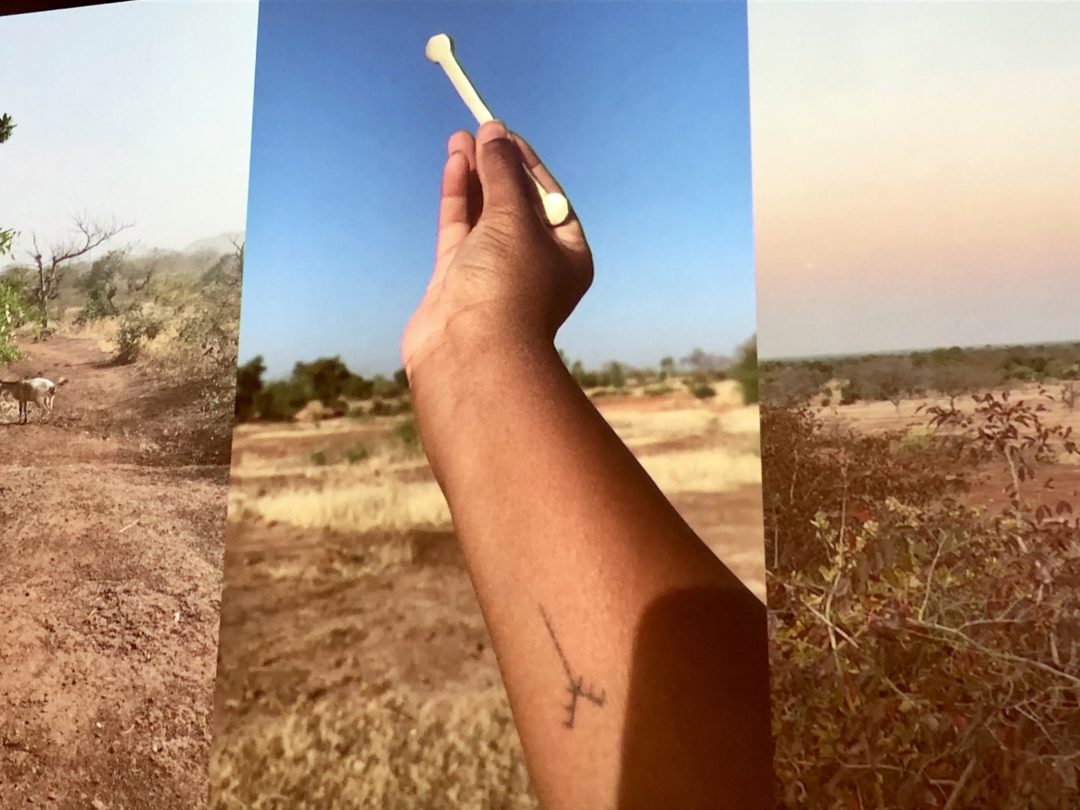CRYSTAL: Well, we’re here at the Liverpool Biennial! I wanted to come because of Khanyisile Mbongwa, because I’m interested in Khanyisile’s collective and care-centred approach to curating. Black feminist scholars and activists – women like Angela Davis, Katherine McKittrick, Christina Sharpe, bell hooks – have had an enormous impact on my thinking and making practices, so I was looking forward to seeing a curatorial programme underpinned by Black feminism. I thought that we would both find it important and moving and that we would have loads to talk about in a conversation review.
TOM: It didn’t quite work out that way.
CRYSTAL: I mean, we certainly talked a lot about the biennial, but not in the way that I thought we would. I don’t think either of us experienced any work that we really loved, which is actually quite rare. I loved that the biennial was curated by Mbongwa, and I loved the diversity of the roster of artists, a number of whom we’ve encountered elsewhere and liked their work, but, for the most part, I just didn’t love the work here or its presentation. We also kept encountering other problems that chipped away at our enjoyment of and engagement with the exhibitions.
TOM: We even made a list.
CRYSTAL: Yes, I think there were six things that bothered us, from curation and execution to concepts and politics. Six seems like a lot. Where should we start?
TOM: I guess we can start where we started – at Tate Liverpool. I actually felt like Torkwase Dyson’s sculptural installation provided a powerful, tone-setting beginning. Three looming, u-shaped objects, like cross-sections of a boat’s hull, spot-lit in a darkened ground-floor gallery. Dark steel around their bottom halves had an industrial feel, while cracking graphite surfaces above alluded to earth and a sense of fragility. The issue for me at this stage was cumulative, in that Dyson’s work, and that of the next three artists, were all presented in the same way: one artist, one work (sometimes two), one room. All similar scales. Quite quickly, it starts to feel plodding, with little possibility of different artists really speaking to one another.
When things do open up a little, for example Lubaina Himid’s two paintings hung opposite Gala Porras Kim’s white-ish canvas infused with mould from the British Museum stores, it’s difficult to see what these works might be saying to each other. I mean, maybe there is a link between the women in Lubaina’s paintings tearing up maps into little pieces and the little pieces removed from objects in the British Museum during the process of extracting the mould. Maybe something about the fiction of tabula rasa and destruction of colonial apparatus. But that feels a bit of a stretch.
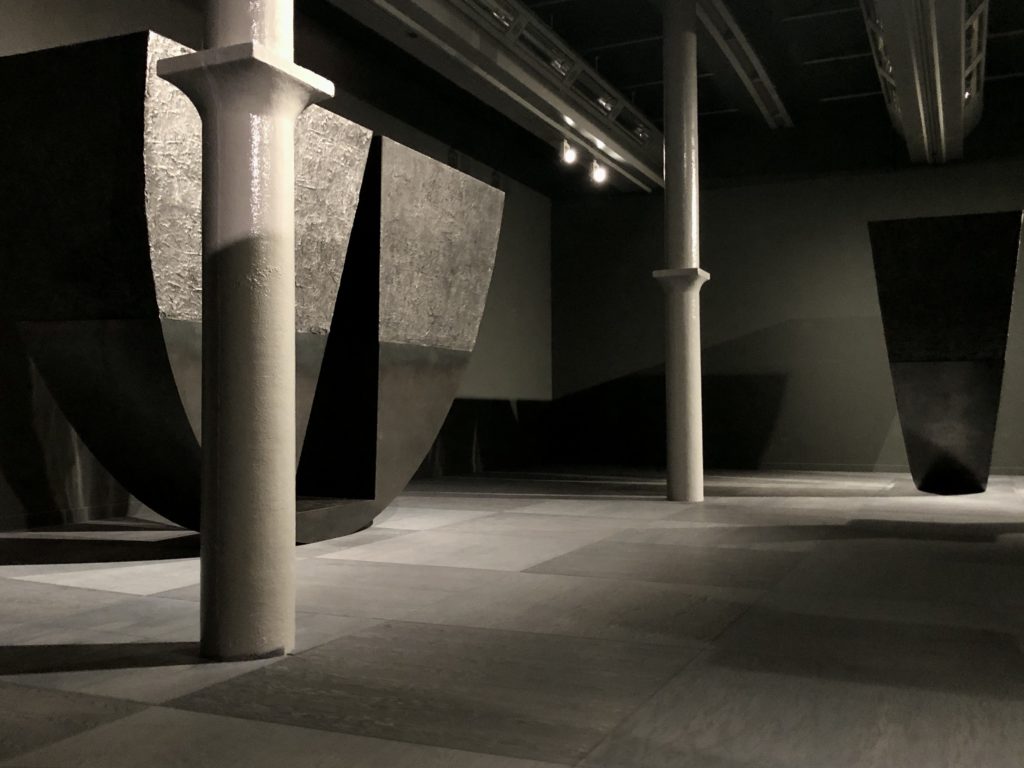

CRYSTAL: I agree about Torkwase Dyson’s installation. If the exhibition upstairs had worked better, her sculptures would have felt like an incredible opening act, a kind of meditative reckoning, at sea level, before moving upstairs to get a sense of some of the promised ‘aliveness’. But almost everything upstairs felt petrified or stagnant, there was a complete lack of liveliness.
TOM: And that relates to the second problem, right?
CRYSTAL: Yes, for me, one of the most acute problems was the absence of rituals and performances outside of the opening weekend. We couldn’t attend the press view or the opening and, when we visited, there was not a single live work taking place. Many reviews in the art press play up the performances and the rituals, but much of what we experienced felt like artefacts or remnants of live performances and rituals, drained of energy.
In Tate Liverpool, you meet the remnants of Edgar Calel’s offering, fruit and vegetables placed on rocks, for a ritual that had already taken place. A few rooms down, you come to Guadalupe Maravilla’s sculptural headdresses for healing body and spirit, which again, felt drained of life, in need of activation through the human body or at least an accompanying moving-image or sound work. In the Tobacco Dock, Albert Ibokwe Khoza’s immersive offering, Black Circus of the Republic of Bantu, was, again, only programmed for the opening weekend. Instead, we were left with remnant props and a video work on the violence of the colonial gaze and the ethnological exhibitions which took place between the 1870s and the 1960s.
If the performances, rituals and offerings are such an important aspect of confronting the wound of the Atlantic slave trade and its traces today, and with finding collective ways to heal and thrive, then I almost wish that Khanyisile Mbongwa had made no exhibitions at all and focused only on a biennial of programmed live works.
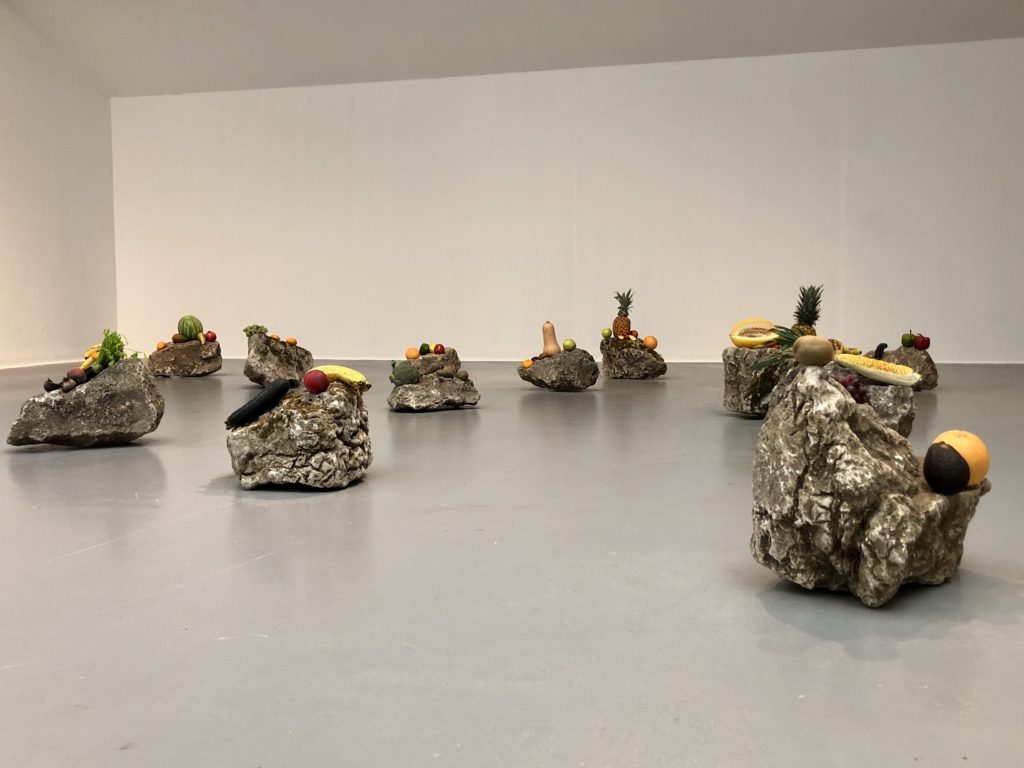
TOM: Yeah, I mean, that’s a classic issue – that for visitors who come after the opening (i.e. everyone) there’s this sense that you’ve arrived too late. It feels like a lack of consideration for audiences who inevitably feel that they are being left out of the conversation. It makes me think about one artist who addresses this sensation specifically in relation to colonialism: Sulaïman Majali. Their work creates this sense of having to inhabit and figure out a world shaped by past events that you can never quite access directly.
CRYSTAL: I appreciate that sometimes it can be an intentional strategy, but I have never felt the inside/outside divide as acutely as I did here. So often, I felt that we missed experiences which read as central to the identity of this biennial.
TOM: For me, a bigger problem was the wall texts throughout the whole thing.
CRYSTAL: Same, the wall texts quickly started to grate. One issue was a disconnect – and I felt this frequently throughout the biennial – between things the artists were saying through their works and things the exhibition texts were saying. Coming back for a second to Lubaina’s work, which I love and loved seeing here, the painting of two Black women gazing at the sea from their balcony seats in the opera is titled Act One, No Maps…
TOM: Yes, and the wall text specifically quotes Lubaina describing her work as “a musing on what would happen if Black women got together and started to try to destroy maps and charts – to undo what had been done.” I really love that line.
CRYSTAL: Me too! And yet the description in the biennial introduction describes many artists as “cartographers redrawing the lines”. Why?
TOM: I don’t know! With mapping such a recurring subject in discussions of colonialism, this kind of discrepancy did feel jarring.
CRYSTAL: Agreed.
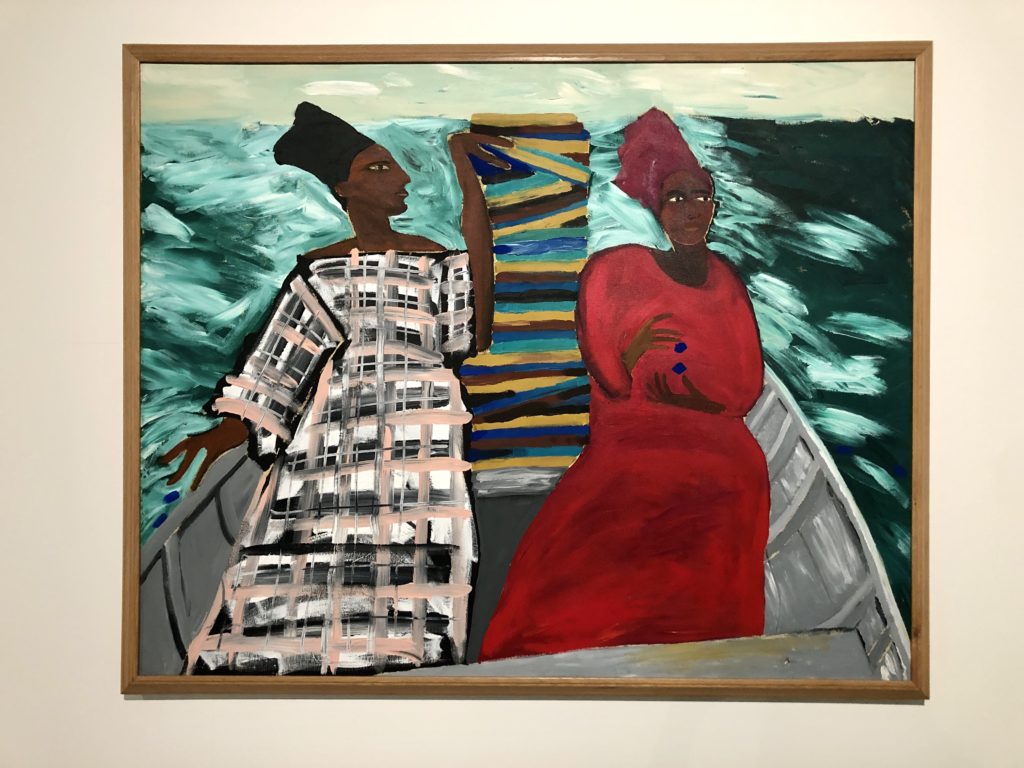
TOM: There were other issues with the wall texts too. This is a boring thing to complain about, but when you don’t know an artist, or their reference points, or the culture they’re discussing, you need some information in order to find your own way around the work. Throughout the whole biennial these were often really poor – giving a lot of words but very little salient information. They were long (3 paragraphs each). They often made grandiose claims about what the work was doing, alluded to broad brush histories and no specifics, and rarely gave you the information you actually need in order to think/feel your own response to the work.
So at Tate, it mentioned that all the objects in Guadalupe Maravilla’s head-dresses had a particular resonance but then never said specifically what. So you were left to wonder: why loofas? Why scorpions? Why feathers made of metal?
At Victoria Gallery & Museum, one of Charmaine Watkiss’s drawings (which I did really like) is full of plants, which I assume had direct references to the Transatlantic slave trade, colonial movement of plants etc. I know a bit about these histories but I’m not so good at recognising plant species. The wall texts told me nothing – not the species or their histories or uses. So you’ve just got to guess, or know it all already – which means your response to the work can only ever be vague and generalised.
At the Tobacco Warehouse, I was really intrigued by the sound work that formed part of Julien Creuzet’s installation. But it wasn’t even mentioned in the wall text! So I was left wondering about the nature of the sounds and instruments, who the singer(s) were. Like, you have three whole paragraphs here. Stop telling me that the work is “intimate” or “powerful” and give me some factual information so that I can figure things out for myself.
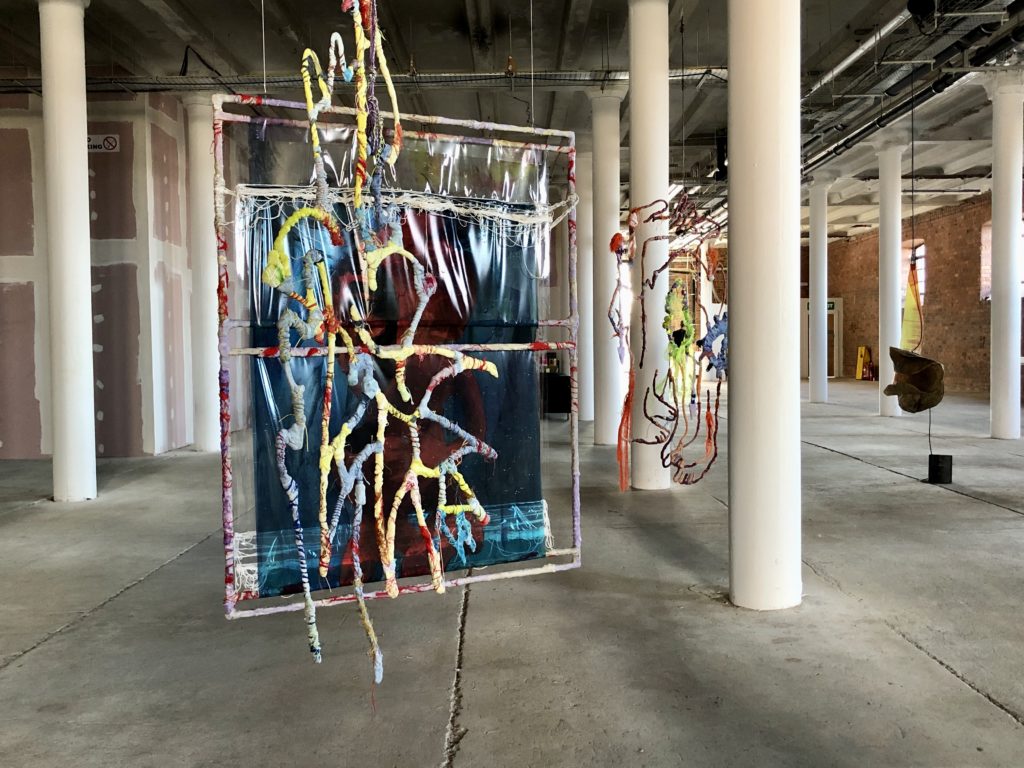
CRYSTAL: Surprisingly, the wall texts were better in the collections exhibition on the second floor of Tate Liverpool. They gave specific information, and often quoted the artist directly. They read as more complex, more alive and more grounded in Liverpool.
TOM: I mean that whole display worked really well. Most obviously refreshing was that suddenly there are lots of things together in the room – a range of media, a range of scales. One thing visible through or alongside another, speaking to or with each other. Your eye starts to make connections, and your mind tries to make sense out of them, that’s what being in a gallery is. The texts help you by giving you relevant information and no more.
CRYSTAL: I think I also just found the works more engaging. I really liked Paulo Nasareth’s The Tree of Forgetting, a series of video works where the artist walks backwards around four different trees, including the ‘tree of forgetting’ in Benin, where captured people were made to walk around the tree seven times to ritualistically erase their memories before they were transported to the Americas as slaves. Nasareth walks backwards 437 times around that tree, as a way to undo and defy the forced ritual of cultural erasure. Simple, but hugely complex: this work spoke to me in a way that many of the works across the Biennial didn’t.
Njideka Akunyili Crosby’s painting, Remain, Thriving, was also a welcome sight. The scene of Black British domesticity was refreshing, but it’s also a complex image with references to Brixton’s Black Cultural Archives and the 2018 Windrush deportations scandal. Kader Attia’s couscous model of the Algerian city of Ghardaïa, with its links to Le Corbusier and relationships between modernism and the cultures of colonised countries, was so intelligent. I liked a lot of the works in that gallery.
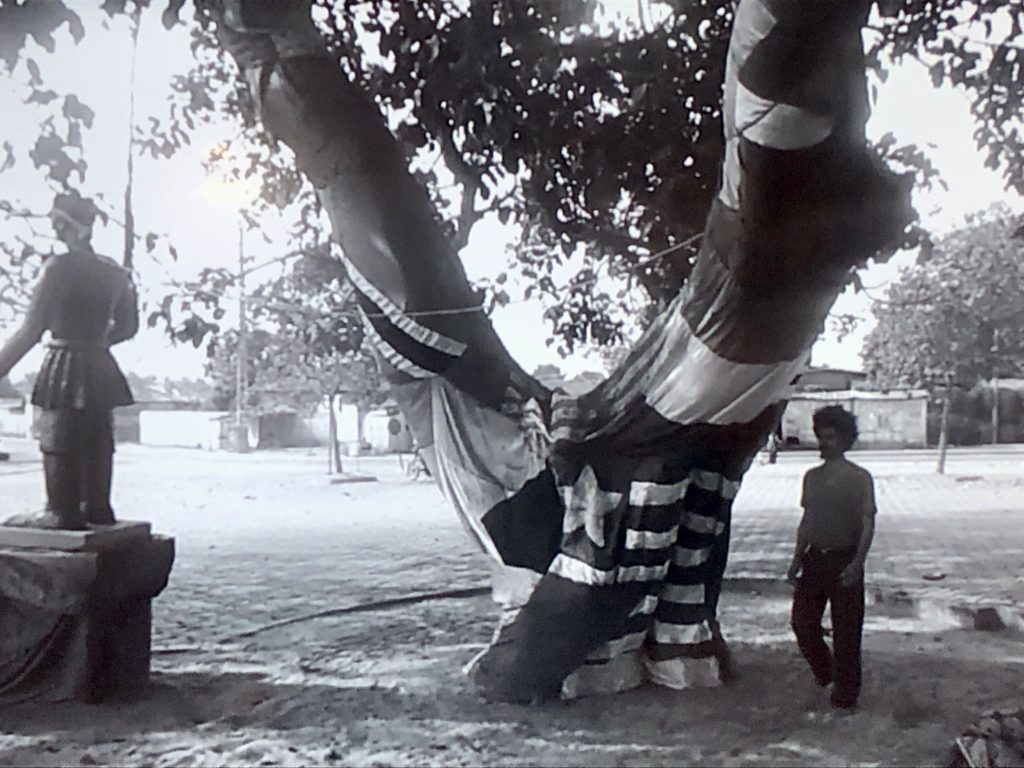
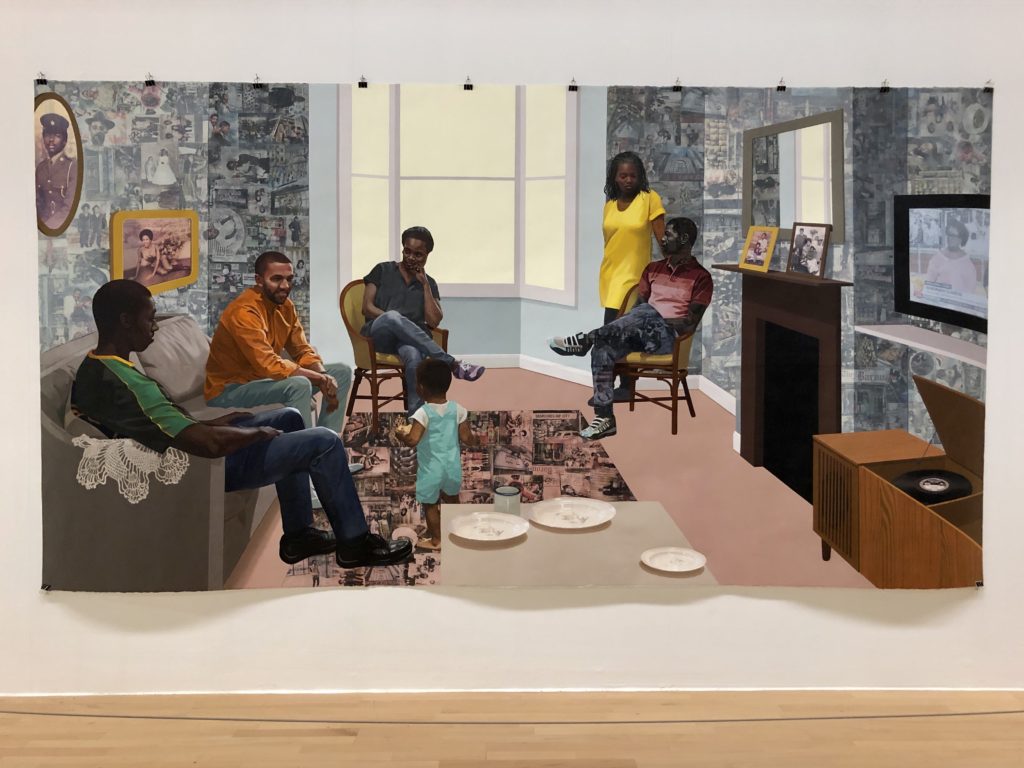
TOM: Yes I loved Nasareth’s piece too. There was something engaging in that simple act, the idea of walking backwards being an undoing, and therefore potentially reparative. I liked the way it was presented – four screens around a column in the gallery, an echo of the tree. It created a strange sensation, as you walked around, suddenly conscious that you’re going the opposite way to the artist. It felt odd, wrong, like my walking was part of what the artist was trying to undo – which, in a way, it is. It made a virtue of a difficult space (those columns) and made me conscious of my body inhabiting, moving through the space, and what that might mean. And the text gave you a few simple (horrific) facts that immediately give you a sense of what this work is doing.
CRYSTAL: Agreed.
TOM: So that’s pacing, performances and texts. Next?
CRYSTAL: Context. I think this biennial didn’t speak strongly enough to Liverpool. There was much mention of the Middle Passage and the Atlantic slave trade, and the fact that Liverpool was a key port for the departure of slave ships, but these connections were almost always incredibly generalised. Few works spoke directly to these histories, really it was only Binta Diaw and, more obliquely, Torkwase Dyson and Nolan Oswald Dennis. There was nothing about the enrichment of the city from the slave trade, visible everywhere in its built environment; nothing about the fact that Liverpool is home to Britain’s oldest Black community or the continuities and legacies of these people on the city’s Black population today. I think it was in the Frieze review, there’s mention of the fact that, during the press conference, someone asked Khanyisile whether or not she had visited Liverpool’s outskirts, home to one of Europe’s oldest Black communities, and she said that she didn’t, suggesting that it would be a “violence”. I admit, I find this position difficult to understand.
It wasn’t until our last day, when we went to the Bluecoat exhibitions and FACT, that I met with work that felt at least a little bit more connected to Liverpool. At FACT, Belinda Kazeem-Kamiński’s film Respire (Liverpool) is underpinned by a powerful statement about the precarity of Black breathing and the importance of creating spaces in which to breathe. But, for me the work suffers from the inclusion of the red balloons that Liverpool’s Black residents breathe into. I imagine the decision stemmed from a desire to visualise the act of breathing, but the choice of red balloons felt gimmicky and made me think of clown noses. The balloons detract from the message.
TOM: Yes, I was chatting to an arts editor who said the same thing about the balloons.
CRYSTAL: Then, at Bluecoat, Kent Chan’s Hot House installation looks at artefacts of tropical provenance held in the World Museum. There seems to be a lot of interesting thinking and research underpinning this work, about relationships between climate and cultures and between museum objects and conversation practices, but these don’t play out in the installation. In particular, the film narration is surprisingly simplistic and doesn’t speak to the concerns set out in the wall text.
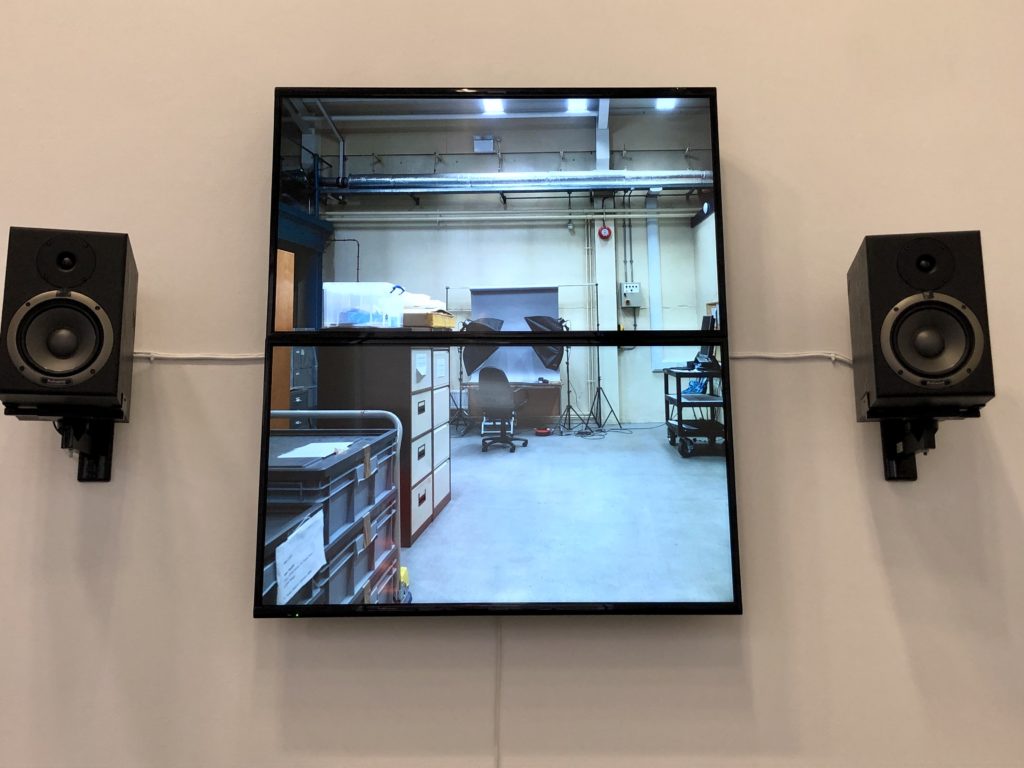
TOM: It’s funny – as I was watching this, I found myself thinking that it felt a bit like something a museum interpretation team might commission, rather than a work of art. But then one of the film’s central questions is how/why certain cultures even feel the need to delineate between a work of art and other kinds of cultural artefacts, and create corresponding hierarchies of value and display. So I enjoyed the way the artist preempted my own thought processes but it did feel odd that this wasn’t actually shown at the World Museum, where it would have spoken more directly to its immediate context.
CRYSTAL: I don’t know, maybe it would have gotten a bit lost in the World Museum, but I broadly agree.
TOM: So issue number 5 on our list is around the politics of the biennial.
CRYSTAL: Over our three days in Liverpool, we spent a lot of time discussing ideas of reckoning and care. With respect to care, we talked a lot about what care means in this context and who gets to be cared for. Does care extend only, or mainly, to the community of artists chosen by the curator to participate? Personally, I think this can be a legitimate and in many respects deeply necessary strategy, but if that was the case, I do wish that it had been more explicitly stated. I think I said to you about ruangrupa and how explicit they were that their documenta was essentially a way for them to redistribute the institution’s financial resources to other artist-collectives. Honesty helps audiences find their footing and provides opportunities for growth and taking responsibility.
TOM: That resonates with a recent interview on Frieze between Torkwase Dyson and Christina Sharpe. Dyson draws a distinction between a work’s audience in a generalised sense and the people she is really speaking to. And Sharpe clarifies that difference: “Anyone can approach, but whether you are included is a different matter. You can overhear a conversation, but you’re still just overhearing it.”
It’s interesting to think about this distinction in the context of the biennial. If the real intended audience is the other artists and affiliated writers, curators etc, then is everyone else just eavesdropping?
CRYSTAL: Unfortunately, racism is such an enormous ongoing problem, however much Britain likes to think of itself as anti-racist, that I understand where the idea of audience inclusion and exclusion comes from. And, considering how toxic relationships can be between artists and art institutions, I do think that there’s a strong case to be made for prioritising the care of the participating artists. But I also think that if care is only for the artists, whether explicitly or implicitly stated, it leaves the visiting public in an inert, voyeuristic position and that’s not ideal either.
It reminds me of an article in a recent issue of The Funambulist on critically examining our solidarities. The article, by Laurel Mei-Singh and Davianna Pōmaika’i McGregor, picked apart problems with the concept of allyship and proposed interdependence as an alternative. I don’t have an answer to this, but I do wonder if care is only conceived of as being something for the community of exhibiting artists, or for a very limited audience, does that deny audiences an opportunity to participate in acts of interdependence and solidarity?
Relatedly, I had hoped to see more connections to solidarities with people and communities who continue to suffer from the legacies of the violent logics of the Atlantic slave trade, connections to migrant struggles, abolition movements and others. Interdependence, solidarities, relational understandings between past and present are the things that draw me to thinkers like Christina Sharpe and Angela Davis. Sharpe’s work on the Atlantic slave trade makes generous, necessary connections between the Middle Passage and the Black and Brown bodies dying in huge numbers this very minute while attempting to cross the Mediterranean Sea. Walking around the biennial, I kept thinking about the recent Pylos shipwreck, in which 600 people were killed and 104 survivors detained in a closed camp, after the Hellenic Coast Guard refused rescue and prevented other vessels from getting involved. For years, Angela Davis has almost never given a speech in which she doesn’t mention Palestinian liberation struggles. At Tate, I looked for Palestine on Nolan Oslwald Dennis’s map of the Earth, representing “a Black consciousness of space”, but couldn’t find it. I hoped for more visible expressions of this kind of solidarity and was disappointed not to find them.
TOM: It’s interesting you mention that issue of The Funambulist as there’s also a short piece by Nolan Oswald Dennis in there. In their biog they say that their work is not about making site-specific interventions but about system-specific interventions, and I think that does resonate with the biennial in general, even if that approach is never clearly stated. Like perhaps the lack of specificity is in order to keep the focus always at the level of the structure. But I mean, surely, as a biennial rather than just one artist, you can do both/and?
CRYSTAL: 100%. I don’t consider site-specific and system-specific as mutually exclusive.
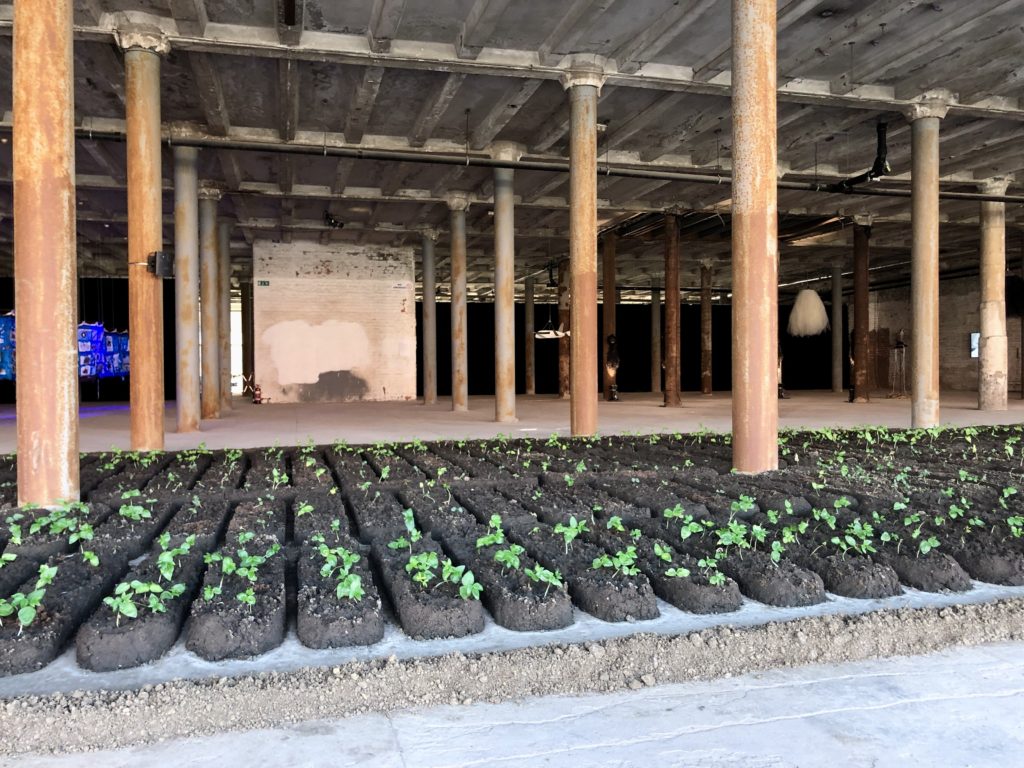
I think the final problem I want to mention is connected to a number of unanticipated resonances which emerged from a seeming lack of thoughtfulness on the part of some of the artists. To give a small example, the wall text for Binta Diaw’s soil map of the Brooks slave ship in the Tobacco dock says that the work speaks to “care” and the soil and seeds “speak to the potential for new life, where new buds can grow, and healing can occur”. Moving my eyes between the text and the work was a jarring experience. The seedlings are in mere inches of soil, straining towards the light, growing in an unnatural way. I found it hard to reconcile the language of care with the fact that the seedlings are in artificial conditions where they will struggle to survive, if they survive at all. Why not put the installation outside, or at least use grow lamps to create conditions where the seeds can genuinely thrive?
TOM: I asked one of the invigilators about the specific plants, which were supposed to be yam, okra and black-eyed peas. But apparently all the yams went mouldy and died.
CRYSTAL: I also struggled with Albert Ibokwe Khoza’s installation. I heard later that during the performance, some visitors had their hands tied up with rope and others had monkey masks placed over their face and were compelled to dance as the artist cracked a whip nearby. Again, the text talks about how the artist “creates a space for collective healing and an opportunity for dignity to be reclaimed”. I really struggle to read a performance that, at least in the retelling, centres on ritual humiliation and lack of consent, as one of creating a space for collective healing. But we didn’t experience the performance, only the remnants, so perhaps the people in attendance felt differently.
But the work I think I struggled with the most was Edgar Calel’s Ru k’ox k’ob’el jun ojer etemab’el (The Echo of an Ancient Form of Knowledge) in Tate Liverpool. Atop a large number of stones scattered throughout a room are a variety of fresh fruits and vegetables, from pineapple and rhubarb to strawberries (always in pairs) and melons. The wall text indicates that the food is an offering to the land and Calel’s ancestors, and that the offering was made during a private ritual (apparently, the evening of the first night of the press view, with many people in attendance).
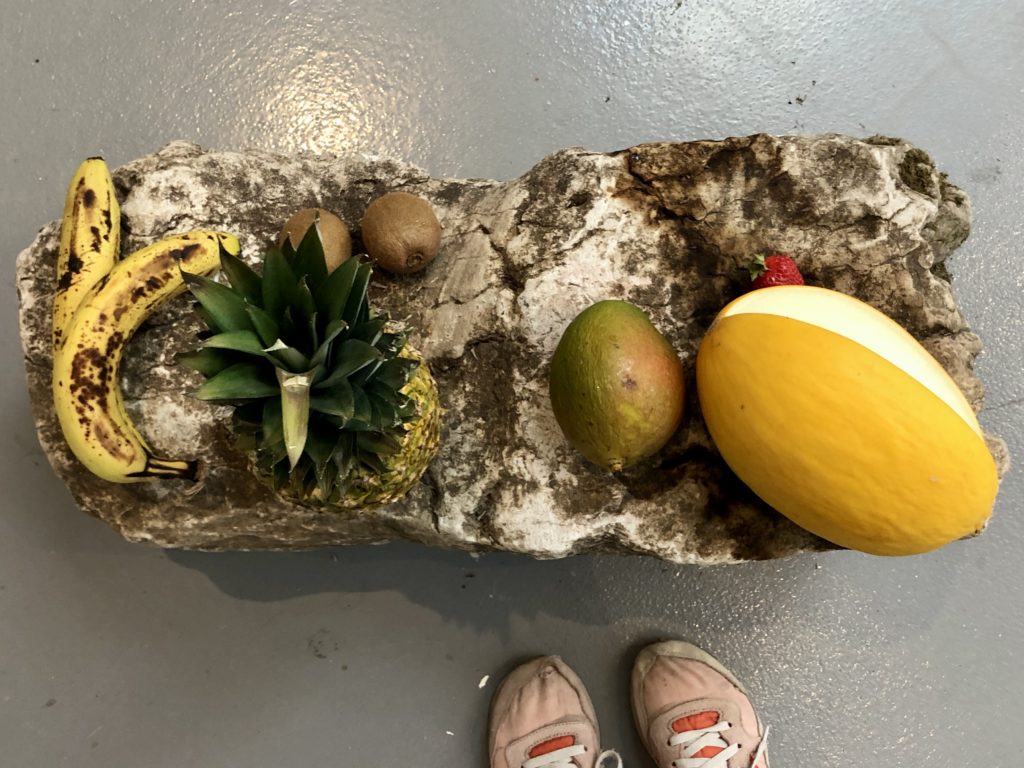
Because this isn’t an artwork but an offering, the artist stipulated that the fresh fruit and vegetables mustn’t be allowed to rot and must be replaced regularly. A conversation with the young invigilator, who mentioned the precariousness of their employment contract, revealed that the fresh produce in the work was indeed frequently replaced. Because the food is effectively rotten by the time of replacement, it’s largely thrown away. So, now the work does two things. It enacts an offering to Calel’s ancestors, but it also serves as a wilful and visible waste of an enormous amount of expensive fruit and veg during an acute cost-of-living crisis. I don’t let myself buy strawberries because they’re so expensive, the invigilator told me, but then I have to sit in here all day and look at slowly rotting fruit no-one can eat.
TOM: I’m not sure if this is a separate point or a subsection of the current one, but one of the things you also mentioned while we were in Liverpool was around the flip side of representing so many different cultures, which is that each artist comes to serve as a representative for their entire community.
CRYSTAL: Yeah, I definitely felt that, in certain contexts more than others.
TOM: One work that managed to get out of this bind, I think, was Brook Andrew’s film SMASH IT, presented at the World Museum. The film splices together found photographs, newspaper cuttings, interviews with Australian Indigenous intellectuals and archival footage to create a multi-layered questioning of reductive approaches to identity or culture. The film doesn’t present a community as unified or self-identical; plurality and internal contradictions are also important truths.

CRYSTAL: I agree. We walked through the African galleries before the film and it was interesting to read about the work the museum has been doing with its displays, particularly the Benin display, in the wake of Black Lives Matter. Although I do think that bringing Liverpool’s Black community to the museum and involving them in conversations around display texts and the presentation of certain artefacts is important, restitution must also be a part of institutional reckoning.
With SMASH IT, I found it initially a little bit confusing—there’s a kind of desktop lecture thing going on with multiple overlapping windows of footage on screen simultaneously. But I also liked the feeling of being confused by the work. I enjoyed the puzzle of trying to understand, or fail to understand in some cases, how the pieces fit together. There were a lot of references that I wasn’t familiar with, but I think we were given enough information to piece things together. More than anything, I liked that the film presented dissenting voices within the Australian Indigenous community. It was refreshing to experience something not rooted in an individual (or worse, an individual acting as a cipher for an entire community), but in a community in discussion. I did enjoy it and I think it’s one of the few works across the Biennial which exposed me to specific knowledge that I didn’t know and which I will read more about in future.
TOM: OK so we both quite liked Brook Andrew’s film. What other positives were there across the biennial?
CRYSTAL: I’ve already mentioned the Lubaina paintings that I liked, Between the Two my Heart is Balanced, in particular. I love how she paints. The big, confident brush strokes, the rendering of the clothes and the faces, the sweeping energy of the bottle-green sea.
TOM: 100% yes. It’s a shame you missed her Tate Modern show – it was so great.

CRYSTAL: I know, I’m sad about that.
I also enjoyed the change of pace with the work at Bluecoat, where three of the artists were given more space. Although, I have to say that found it hard to fully enjoy the work here because of friends who have had terrible experiences exhibiting at the gallery in the past.
Raisa Kabir’s work was interesting, a lot on textiles, labour and the cultural politics of cloth. Again, I was sorry that we missed the performance in the opening weekend, as most of these works were made to be activated by Kabir’s body, but the videos helped mitigate that somewhat.
TOM: One thing I really enjoyed about Kabir’s work was the way that, in order to watch the film piece, you sat at a table strewn with photocopied pages from the artist’s notebooks. You pick one up, have a bit of a read, put it back, read another. There are research notes on the 1857 Bengal uprising and the role of the East India Company, jottings on labour and colonialism, ideas about disabled bodies and time. It’s a really effective way to give people snippets of information about the research that underpins the work, without relying on copious wall texts.
Another positive for me was Gala Porras Kim. Having complained about the samey pacing at Tate Liverpool (one artist, one work, one room), I really appreciated Mbongwa’s decision to include three separate works by Kim, each in different locations across the biennial. I wish curators would do this more often. Allowing an artist to include multiple works and not just sticking them altogether, but allowing your response to their works to change and develop as your journey through the biennial continues. So, I really like the idea of the mould work, although I think it could have been shown better, and I wasn’t totally sold on Roll Call, a declamation in the foyer of the World Museum of names associated with museum objects. But I loved Future Spaces Replicate Earlier Spaces, the drawings of shells, formerly used as wind instruments. I liked that you could see the numbers stamped upon them, evidence of a (potentially violent) shift in use – from living protection to source of ritual music (both activated by bodies) to inert museum artefact. Linking these three works in my mind, I really felt this sense of a living vocal wind that the curator talks so much about blowing its way through the biennial, connecting venues and works, rippling back and forth between the living and the dead.
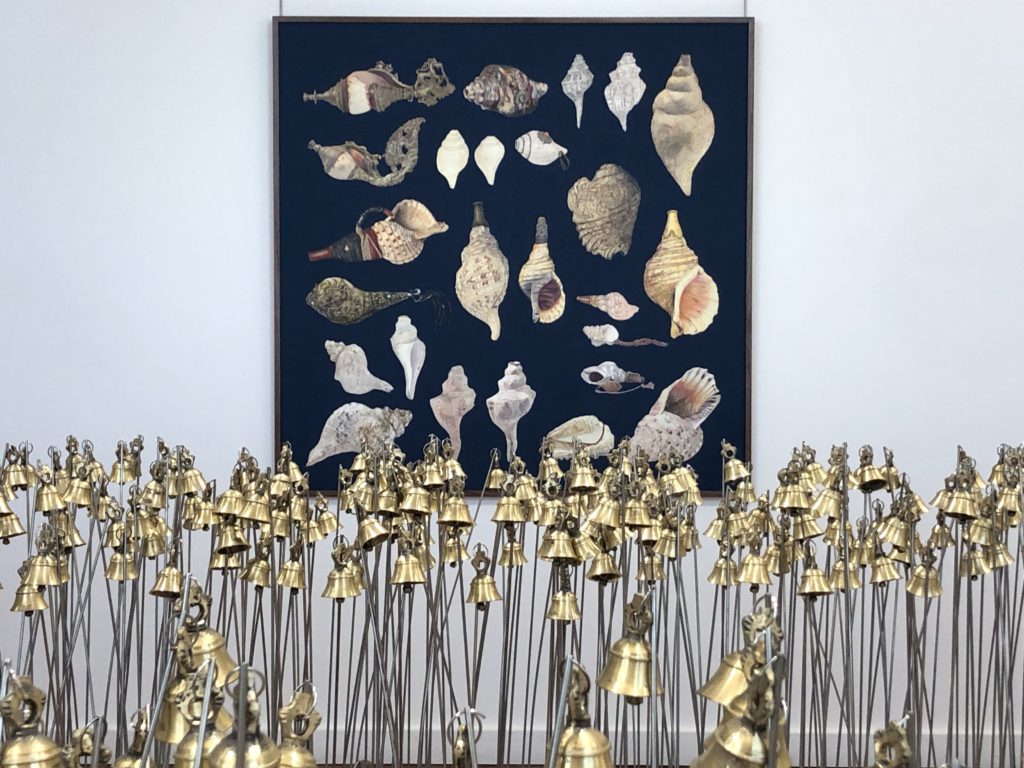
CRYSTAL: Yeah, I just didn’t get that. I’m super into the politics of museum collections and conservation, so this all should have been right up my street, but the works didn’t come together for me in a way that moved my thinking or feeling on the subject. I also found it really strange that the works engaged with collections in the British Museum and not with an institution in Liverpool.
TOM: Yeah I’d agree with that. I’ve already mentioned Charmaine Watkiss’s work, which I also liked. I think the little side room helped create an intimate sense of ritual with the drawings forming a kind of ring around the votive figure and cluster of clay tobacco pipes in the centre without the need for a live event to activate it. The drawings were beautiful too, similar in some ways to Annalee Davis’s work, which I absolutely love.
CRYSTAL: I suppose I was most drawn to Rahima Gambo’s film and installation at Open Eye, Nest-works and Wander-lines and Instruments of Air. The work – an assemblage of films of Gambo walking while holding up different objects – was rooted in an individual, but this individual was connected and connecting to a specific place and specific ideas around symbols, landscapes, language before language. It also felt very alive, very present, but very gentle as well. It almost seemed like I was walking through rural Laongo in Burkina Faso with the artist, having conversation without words. It felt like a meditation.
TOM: We should also talk about the Melanie Manchot film, which stuck out like a sore thumb.
CRYSTAL: In terms of the film itself, I liked certain aspects of it, but also felt like it was quite cliched in a way – very Joseph Campbell’s Hero’s Journey. But I didn’t hate certain of the constructed elements. The wall text referred to it as playing with fact and fiction, which is a lazy description – I thought it was more a dissection of the idea of reconstruction, in relation to the specific theme of gambling addiction. It’s an important subject and I’m glad to see it addressed, but it’s not something that will stay with me. And yes, it did feel jarringly out of place with the rest of the biennial.
TOM: Agreed. This was commissioned under a previous director, I think it was Fatos Üstek, who resigned amid some controversy in 2020. Leaving aside the actual film, its very presence here points to a confusing relationship between the biennial as an organisation, the curator (who is only ever a temporary presence), and the partner institutions across the city. Clearly, each of these will have slightly different priorities and in an ideal situation they all align reasonably well. But when they don’t, in continuing to pretend that there is institutional cohesion, in attempting to speak with one voice, the result is mixed messages and an obscurity about who is responsible for what.
More broadly, maybe Khanyisile Mbongwa’s talk of a reckoning was as much to do with the structural issues of the biennial itself. On the train home I read that White Pube piece from five years ago which criticises the structures of the biennial in a lot of detail. Like, it’s a nightmare to work for, all the top staff are white, they overspend, treat junior staff and volunteers really badly, and are basically hated by everyone in Liverpool. I don’t know the extent to which that is true, but it sounds like a familiar story.
CRYSTAL: Yeah, I had heard something similar, so the biennial clearly doesn’t have a great reputation historically. So, I do wonder whether or not the situation has changed, and if this incarnation has contributed to improving things?
TOM: It’s hard to know at this stage, especially as an outsider.
CRYSTAL: That said, I really don’t think that it’s the responsibility of an external curator to come in and clean up an institution’s structural problems.
TOM: You’re totally right. Institutions need to take some responsibility for themselves.
The Liverpool Biennial continues until 17 September, 2023
Image credits (from top), all photos Crystal Bennes
1. Installation view of Rahima Gambo, ‘Instruments of Air’ (2021)
2. Installation view and detail of Torkwase Dyson, ‘Liquid a Place’ (2021)
3. Edgar Calel, ‘Ru k’ox k’ob’el jun ojer etemab’el (The Echo of an Ancient Form of Knowledge)’ (2021)
4. Lubaina Himid, ‘Between the Two my Heart is Balanced’ (1991)
5. Julien Creuzet, ‘Orpheus was musing upon braised words, under the light rain of a blazing fog, snakes are deaf and dumb anyway, oblivious buried in the depths of insomnia’ (2022)
6. Paulo Nazareth, ‘The Tree of Forgetting’ (2012-13)
7. Njideka Akunyili Crosby, ‘Remain, Thriving’ (2018)
8. Installation view of Kent Chan, ‘Hot House’ (2023)
9. Installation view of Binta Diaw ‘Chorus of Soil’ (2023)
10. Detail of Edgar Calel, ‘Ru k’ox k’ob’el jun ojer etemab’el (The Echo of an Ancient Form of Knowledge)’ (2021)
11. Installation view of Brook Andrew, ‘SMASH IT’ (2018)
12. Installation view of Raisa Kabir exhibition at Bluecoat (2016-present)
13. Gala Porras-Kim, ‘Future spaces replicate earlier spaces (shell instruments)’ (2023)

